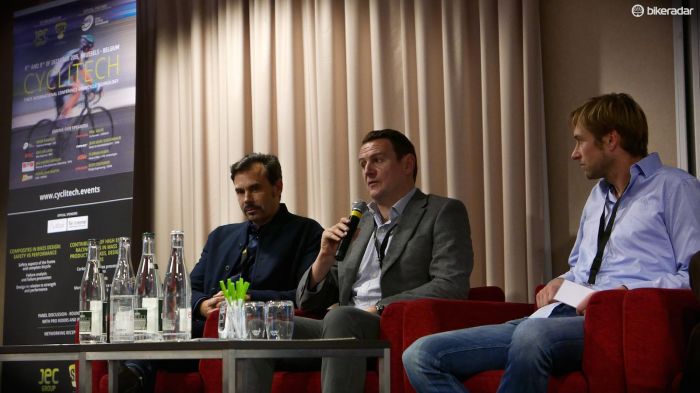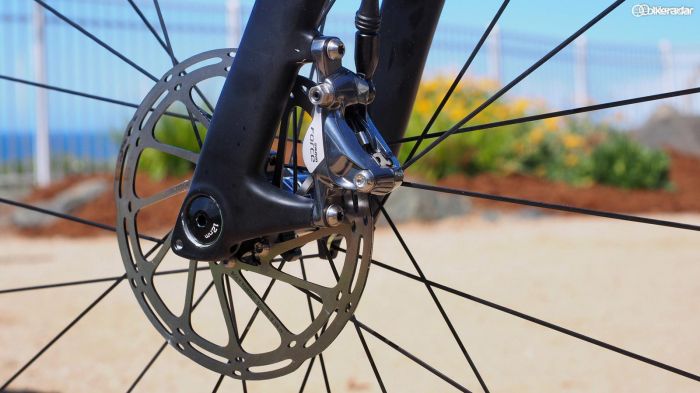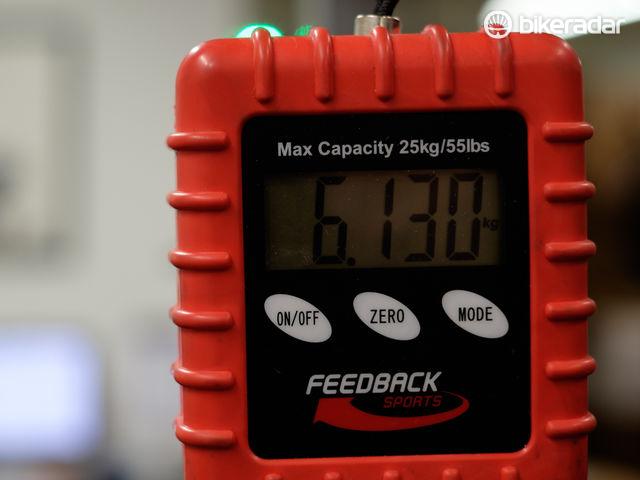Q & A: UCI Technical Manager Mark Barfield on road disc brakes and the weight limit
Sport's governing body signals a new openness to technological innovation

This article originally appeared on BikeRadar
UCI approves widespread disc brakes use in 2016 professional peloton
News shorts: Cyclingnews readers in favour of disc brakes, Rusvelo becomes Gazprom
Nibali in favour of disc brakes in pro peloton but worried about crashes
Trek Factory Racing decline to use disc brakes at Tour Down Under
CPA believes testing disc brakes in peloton could cause crashes
It's long been a gripe of many within the bike industry that the mass of UCI regulations that proscribe almost every element of a road bike's design are outdated and have hindered innovation and creativity.
The news that a trial of road bike disc brakes by the sport's top teams would continue into 2016 has caused much speculation but it's also signalled that big changes are afoot with the way the sport's governing body wants to regulate and interact with manufacturers, riders and teams. We caught up with the UCI's Technical Manager Mark Barfield at the Cyclitech Conference in Brussels for a brief chat about rotors, riders and regulations.
BikeRadar: The UCI has allowed teams to trial disc brakes for 2016 – has an axle and disc rotor dimension standard been set?
Mark Barfield: Yes, there was a meeting back in November and an 'agreed common specification' – the wording behind that is very important. This is not an imposed standard and the reason for this is that this is a trial year, so at the end of the trial year they may well go "Do you know what, we need different axles, different rotor sizes…" but it's been agreed between all of the manufacturers and more importantly with all of the neutral service providers as well. So, it's a standard rotor size, it's a thru axle – it's a common agreed specification.
[Word is this agreed specification is for 160mm rotors, with Shimano-type 12mm E-thru axles front and rear. BikeRadar is waiting on confirmation of exactly what these specs will be and will update this article then]
BR: Was there a consultation process with the riders to come to this trial of discs, or is the trial part of this process?
Get The Leadout Newsletter
The latest race content, interviews, features, reviews and expert buying guides, direct to your inbox!
MB: First of all it is a trial, so I think that's part of the process, this is not a rule change, we're seeking feedback throughout the year. We ran trials for teams during August and September and during that we gave out rider and mechanic questionnaires. Actually, there was a lot of wandering around team buses before and after events asking how it had gone, so we were gaining feedback that way and will do next year through really encouraging riders, mechanics, teams, commissaires and race organisers to talk to us about this.

2016 is very much a trial
It very much is a trial, something that has passed some people by. There was a formal consultation back in March and April and we used the representative bodies. When I talk to the industry, I talk primarily with the World Federation of the Sporting Goods Industry (WFSGI). I've spoken to some manufacturers today and they've said "I'm not a WFSGI member" so, I'll try and keep [them] in the loop, but if I was to have to email every single manufacturer when I'm trying to get some information or get a message out it's quite difficult, so we do use WFSGI.
We also use Association International des Groupes Cyclistes Professionels (AIGCP) to talk to the teams for exactly the same reasons. And we used International Association of Cycling Race Organizers (AIOCC) to talk to race organisers so they were part of the consultation, as were the Cyclistes Professionnels Associés (CPA, the rider's union).
We have put a proposal to the UCI Management Committee to allow the CPA to have a representative on the Equipment Commission, so that's the group that makes decisions. If the Management Committee approves this we'd be looking for a representative to be part of that group for at least two years, because there are things you have to learn.
They have two meetings a year and they get papers that come through, maybe 200-250 pages, including evidence that needs to be read. We try to make evidence-based, not emotional-based decisions and therefore if they want to be part of that group, they've got to be part of the group to express their view, but it is in the context of that the group has representatives from the industry, the fans, the teams. Rolf Aldag is part of that group, [UCI composite expert] Dr Manson is an engineer who's part of that group, a team mechanic from CMC is part of that group, so it's a very wide group and I think a rider representative is probably appropriate, but that's for the Management Committee to decide. That will form part of that consultation, so we consult with the bodies AOICC, WFSGI, IOC and CPA.
BR: Are there going to be any regulations on rim width, construction of the rim or tyre width?
MB: As part of the announcement last week, there were quite a few bits announced in terms of technical changes and because disc brakes were big news, they went under the radar. We've altered our wheel test, so we've moved from, up until the end of the year, the test that we call a 'rupture test'.
They basically take a wheel and they smash it up and they see how the carbon breaks. We didn't feel that was an appropriate test, and when I say we, it was the industry that drove this. They said "We need to move to a safety based test, we need to move to something that is more inline with an EN-type test." The industry went away and worked with the guy that was doing part of my role previously to generate this test, so I picked this up and saw it over the line, I only did the last bits of this. It was a fantastic example of the industry working with the UCI and actually the industry working with each other. I could show you a photograph based at DT Swiss of pretty much every significant wheel manufacturer in the world at that place, doing some testing, all working together – it's just without precedent. It's really, really good.
The new safety-based test is a flat anvil strike test at a certain energy level, which very much represents the forces put through a wheel in competition. Rolf Aldag [MTN-Qhubeka performance manager] is part of the group and Rolf was talking about the wheels Tom Boonen won Paris Roubaix on [Zipp 303s] and how they were tested. We probably used them as a bit of a standard-setter here, so there are really appropriate standards being put into place.
With the new wheel test in place we won't need to govern, we won't go into any more specific detail about the rims. There are other [details] – ETRTO which covers the depth of the tyre, all that stuff – so I think the new wheel test will cover all that for us, but without touching on the weight limit at all. In fact it's the first departure for us into very much a safety based standard and we're really pleased with the new wheel one, really proud that we got it over the line and it will do what needs to be done in that area.
BR: Are new technologies such as tubeless tyres likely to be subject to regulation?
MB: No. The only way we would get involved is if we saw that it had a safety implication. I have no evidence that suggests that it does, so if teams want to trial it or run it, that's fine. My aim is to simplify the rulebook, not to add additional rules. Therefore if innovation is taking place and there is no rule to prevent them and there's no safety implication of them being there, it's probably not our role to stop it.
BR: Does this signal that the UCI may move from current regulations such as the 6.8kg weight limit to regulations based on safety testing?
MB: I think even our direction has been fairly open about the fact that weight limit is a bit of a relic of the past. It no longer does what it set out to do, if it ever did, and as I said in the conference this morning, you can build a safe bike at five kilos and you can build an unsafe bike at ten, so therefore adding a weight to a particular piece of equipment is irrelevant.

Lightweight bikes can be safe, and the UCI recognises that
In my mind it has to be a safety-based standard. I believe the industry is with me on this, but we have a lot of work to do. We've started that, we had our first meetings on this last month but it's a work in progress. I feel we're going in the right direction. I feel there's a general agreement but I wouldn't expect any announcements too soon.
BR: Is that because the Olympic Games are happening next year?
MB: Certainly, [but] I'd go beyond that. I think if you take – really consider this – if we're going to remove that weight limit, bike manufacturers have more of a free hand inside the safety limits that are already in place and they [will] do their own testing, we saw some of that this morning. Their production cycle, it depends on manufacturer, but it runs from two to two and a half years from drawing board to actually rolling something out of the factory door, so that's the amount of time I think we're probably looking at.
BR: As technology has developed, it's often run into the regulations. Do you see that interaction changing?
MB: I think if you look back historically, the regulations were reactive, but in the wrong way, in as much as they reacted to stop some of the designs I put on the wall this morning [fairings, different rider positions, non-standard frame shapes]. Rightly or wrongly, we can all hold an opinion on that, but they reacted to innovation.
I would like and what I've been working hard at in the past nine months – and I accept it's a long journey – is to change the relationship with engineers, with the industry, designers, all of that, to try and encourage a more open dialogue. So, at no point – and I've had lots of suggestions today – are we going to say "Yeah, we're not going to do that". What I'm saying is, "Come talk to me again, come and explain what you want to do and why."
Now, the UCI is not going to roll over on all of those and just say: "Yes, you can do that, yes, you can do that," but we want to have the dialogue and we want to explain our position, explain what our concerns are and try and help the industry get to a point where it can innovate and be healthy inside the constraints we find ourselves under as well; [keeping the sport] more about the athlete [than the kit], a recognisable bike, keeping the Lugano charter in mind to ensure the International Olympic Committee recognises things as well – and that's important for us, really important.
It's a brokering kind of job. That's why I'm not an engineer, I'm not a scientist, I'm a manager that works in sport and that means you're trying to spin the plates, keep people happy. It's teams, it's manufacturers, it's riders and sometimes you're dealing with riders who want different things to their teams. We're not really an arbitration service here but you're dealing with different stakeholders and that's the tricky bit I guess. If you only listened to one group you'd make them really, really happy and very rapidly find out who you haven't. People don't stew silently in this game!
This interview has been lightly edited for clarity